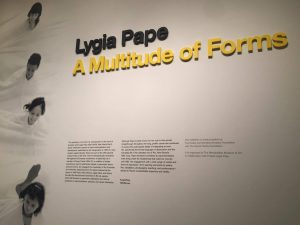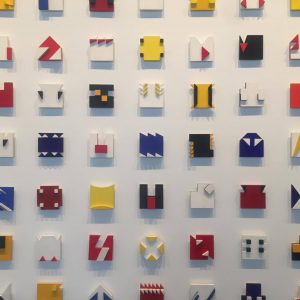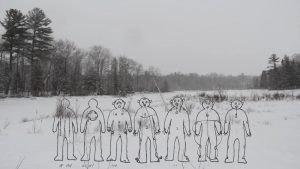For my last blog assignment, I went to the Met Breuer to visit the Lygia Pape Exhibition. I was absolutely in love. I have never heard of Lygia Pape before I went to the exhibition and had no idea what kind of artist she was. From the moment I walked in, every piece of art resonates in my heart. The reason why I love her work is because I am a huuuuuuge minimalist. I;m not saying her work is totally minimalistic, but it definitely had that kind of impact on me. Each piece was so simple, yet intricate at the same time.
am a huuuuuuge minimalist. I;m not saying her work is totally minimalistic, but it definitely had that kind of impact on me. Each piece was so simple, yet intricate at the same time.
There were a series of favorite pieces of art at the exhibition. Not to mention, her color palette was beautiful. I loved the yellow, black, and gray, as well as pops of red, green, and blue, and a base of white. Some of my favorites would have to be….




There was a wall filled with colorful patterns (the one shown all the way at the right above). I’m not sure what this wall signifies, but to me, it felt like different patterns fitting well when put together. Almost as if it’s talking about different people, cultures, languages, can all come together, unified. The colors were popping right off the white wall, literally, because these patterns are 3D. If she was alive… I would want to work under her and learn to be as creative as she is.
Another one of my absolute favorites was this piece. (picture shown below). It’s white and yellow and stunning. It kind of reminds me of mountains, bu t honestly, it’s just one of those pieces I adore without much analysis. It’s aesthetically pleasing and I would love to take it home. I forgot what it was called, but nevertheless, I loved it.
t honestly, it’s just one of those pieces I adore without much analysis. It’s aesthetically pleasing and I would love to take it home. I forgot what it was called, but nevertheless, I loved it.
A experimental film that I enjoyed was called Ballet neoconcreto I (Neoconcreto Ballet I) 1958. According to the little information plate they show next to the film, the film is based on a Concrete poem by Reynaldo Jardim. In the peom, Jardim states eye and target, which I’m still not sure what it really means. Pape’s rendition used blocks to represent “eye” and “target”. The blocks were a combination of cylinders and rectangles. They would move within the film, creating this ballet(?) In the information plate, it states, “Pape replaced the simulated movements and imaginary settings of traditional theater with the concrete drama of basic forms shifting in space and times”. Such a simple film with such depth and meaningful purpose.
The Lygia Pape exhibition has definitely opened my eyes and inspired me to continue to create minimal work. I absolutely loved everything she created and I think Pape is a renowned artist to have her own stylistic choices and patterns. I believe that her work of art will continue to inspire many other artists out there.
If you haven’t gone to this exhibition, I would highly recommend to go before it closes because I’m sure you won’t regret it. I’d probably go again.

